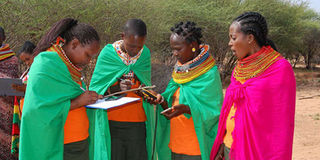Mama Tembos: New face of conservation in Samburu

Some members of the Mama Tembos project in Samburu County on December 11, 2018 go about their business. The group promotes wildlife conservation. PHOTO | FRANCIS MUREITHI | NATION MEDIA GROUP
What you need to know:
- They record animal movements and send signals of attempts to create settlements along the migratory routes used by elephants and other wildlife in the region.
- These formerly stay-at-home mothers are now respected community leaders and are a role model. They are now able to provide for their families.
As they bravely step into the harsh terrain of the northern corridor in Archer’s Post at the tip of Samburu County, the untrained eye could mistake them for women gathering firewood.
But their coordinated movements and intense concentration tell a different story. They are on a wildlife conservation mission and have no regrets for abandoning their early morning motherly roles.
“It’s great to be in the bush in the morning. It’s exciting to know your work is not in vain,” Ms Mary Nadite, 27, the group leader, says.
And as they weave their way deep into the migratory route of the elephants in one of Kenya’s greatest wilderness, each step they take forward is well a calculated movement.
They record animal movements and send signals of attempts to create settlements along the migratory routes used by elephants and other wildlife in the region.
REVENUE
An early morning encounter with a herd of elephants walking along Ewaso Ng’iro river to quench their thirst has become a normal interaction.
“Our weapons are not guns or spears. We are armed with GPS tracking devices, data folders for collecting data on wildlife movements and signs of construction of illegal bomas that could potentially block wildlife and livestock movements,” Ms Nadite said.
The mother of four said the protection of these pathways is critical as they are avenues for animals to find water and food.
But it has not been a walk in the park for these courageous and determined women.
Occasionally their movement is temporarily halted as their colourful lesos hanging loosely on their necks ringed with beautiful beads are stuck in between the razor sharp thorns protruding from the acacia trees that form a beautiful canopy over their heads.
“It’s painful. The thorns cut into my face and sometimes my hands but I have no regrets. Elephants attract tourists and earn this country millions in foreign cash,” Ms Nadite adds.
VIOLENCE
Their efforts are reducing tension and bloody conflicts that have left many women widowed and children orphaned.
“We’re extending our new found unity of purpose to our communities as we preach the gospel of saving the elephants,” she says.
“The beauty of this project is that it has gone beyond its expectation as we are now witnessing more handshakes in our two communities.”
The nine women, popularly known as Mama Tembos, are working in the community led corridor project in Kalama conservancy and Save The Elephants — situated in Archer’s Post Gir-Gir group ranch.
They are the new found missing link to successful conservation and anti-poaching initiatives. And their selection to join the Mama Tembos was a serious exercise.
It was through thorough public participation where the community was guided by their elders on who to pick for the tough jobs.
POACHERS
Qualities such as discipline, resilience, hard work and courage to speak about evils in the communities were some of the qualities used to pick the nine members of the group.
“The women have proved that when women are given an opportunity, they have the mettle to protect our elephants and other wildlife,” Mr Jerenimo Lepirei, a research and outreach officer for Save The Elephants project, says.
Mr Lepirei said the group is part of the long-term solution to protect elephants that are under grave threat from poachers in the wider Samburu-Laikipia ecosystem.
And for nearly one year since the project began, there have been less reports of human-wildlife conflict that were the order of the day around the conservancies neighbouring the vast Samburu National Reserve. The reserve is home to more than 1,000 elephants.
RESPECTED
These formerly stay-at-home mothers are now respected community leaders and are a role model. They are now able to provide for their families. “It was difficulty to depend on my husband. I no longer have to do that,” Ms Nadite says.
It’s now common for them to be consulted before major development decisions are made.
“In every meeting or baraza I attend, my gospel is always the same: ‘If you do something wrong to the elephants, we shall track you down to your hideouts,"' Ms Jenerica Loolel, 24, says.
Ms Christine Mpuson, 24, said: “The elephants will not disappear as long as I’m a member of Mama Tembos. I will make sure they live forever.”
Kalama Community Wildlife Conservancy’s Tom Lolosoli said the Mama Tembos project is an eye opener to the pastoralists communities in Samburu.




